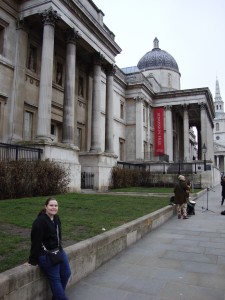The building that houses the National Gallery was an old official looking structure that seemed to say “We hold very important things within our walls.” It was situated by Trafalgar’s Square, a stone park with no greenery in it, but there were large statues and a fountain. In class, we had talked about how the more official looking a building is, the more formal the people inside tend to act. This behavior includes the patrons, the tour guides, the front desk staff and the guards watching over the artwork. This museum was no exception to this unofficial rule.
Our large group of eleven students was split in into groups of five and six for the tour today. My group had arrived a little late for our tour due to delays on the Tube but we were able to join up before the tour had left the lobby of the Sainsbury Wing of the National Gallery. Our tour guide, Rebecca, was holding up a book of letters from Vincent Van Gogh and was talking to the group of about 30 people we were about to join about the special exhibit regarding these letters somewhere in the gallery. She did not lead the group there but instead went up to show us this beautiful altar piece painted to show the Assumption, meaning the rise to Heaven, of the Virgin Mary. Most of the pieces we looked at today either had a religious theme. According to our guide, even the most famous painting in the world, Van Gogh’s Sunflowers, was painted because Van Gogh wanted to use sunflowers to convert people to Christianity. These are the kind of paintings Rebecca liked and this is what we were shown.
The only painting that was not either a Greek goddess or a scene from the Bible shown to the tour group was a painting of Rembrandt’s mistress Hendrickje Stoffels. Rebecca had a story for every piece she showed us and had a knack for talking about everything in so much detail that it was easy to fall into the stories she related to all of us on the tour. Afterwards, Henry told us that he had been advised once to look at paintings like they are scenes in a play and the tour guide seemed to draw further into these scenes with plot points and important details. Having worked at the museum for twenty-five years, Rebecca had a lot of knowledge about everything we saw and was not shy about sharing what she knew.
She was also very accommodating to people who were less able to move around the museum and pushed one older woman in a wheelchair around. “I’ve taken my mother around the museum many times and she’s 94, so I’m quite talented at pushing a wheel chair,” she said as she would position this woman at the best angle to view whatever painting she was explaining. I don’t think the other tour guides we had would have been so willing to push someone else around and try to talk about what they were showing at the same time, so it was refreshing to see that she was willing to include everyone in her tour who wanted to participate.
One painting in particular that has had an interesting history at the Gallery is a nude painting of Venus titled The Toilet of Venus. It was painted by Velazquez and shows Venus in a rather provocative, feline pose looking in a mirror that was held by Cupid. The National Gallery had bought the painting from an English Aristocrat and hung it up despite the anger of British suffragettes. They felt the painting was degrading to women and one suffragette actually hacked away at the painting with an axe. This lead to an uproar from supporters of the museum, who felt that she attacked the painting as if it was a real person; because of this, the painting is now restored and covered in glass. Rebecca really enjoyed telling this story because her great grandmother knew the family who originally bought the painting and pointed out where people could still see the faint white lines; the evidence of the attack.
Rebecca played the part of storyteller very well and was able to engage the audience, even if she got the impression that we were all a bit shy about asking questions. I think it is because she did an excellent job of describing the paintings and we didn’t have to ask her anything. The thoroughness of description and passion she showed with every piece we saw is the mark of a good tour guide. She was able to make the gallery personal to herself and everyone on her tour, including me. This made the audience more engaged with what she was saying.
Is the National Gallery a worthwhile place to visit? You can miss a lot if you speed walk through to see the most important pieces. I would suggest touring with Rebecca to look at pieces that might not be shown on most tours and to truly appreciate everything in a picture rather then just skimming over it. The paintings are beautiful, but to go with someone with a trained eye, who can tell you what the meaning of the little dog in the lower right hand corner of Diana and Aceteon or who can say why some angels have green wings in the Assumption altar piece is what truly makes this trip worthwhile.
